73 Worked Examples: Bluff Body Flows
These worked examples have been fielded as homework problems or exam questions.
Worked Example #1
As part of the design of a building structure in Florida, a component is to be tested in a wind tunnel to measure its drag at speeds equivalent to those of a Category 5 hurricane. The component is in the form of a bluff body with an estimated drag coefficient of 0.98. The projected cross-sectional area of the component is 3.26 ft. As part of the test plan, the drag force on the component must be estimated before it is mounted on the wind tunnel balance system. Make a plot of the estimated drag force as a function of wind speed up to 156 mph. Assume MSL ISA conditions.
The component is a bluff body with and an area
ft
. The drag
will be
where slugs/ft
based on MSL ISA conditions. Therefore,
remembering that to convert from mph to ft/s, we must multiply by 1.467. Therefore, it is now a matter of plotting (in pounds) versus wind speed (in miles per hour) over the specified range using the previous equation, as shown in the plot below.

Worked Example #2
A payload crate is dropped by parachute from a military transport airplane 2,000 m above the ground. The parachute quickly opens, and the crate descends vertically toward the ground. The crate has a mass of 76 kg, a projected cross-sectional area of 0.4 m, and a drag coefficient of 1.5 based on this area. The parachute has an area of 52 m
and a drag coefficient of 1.87 based on its projected area. You may assume the average air density during the descent is 1.19 kg/m
. (a) Determine the vertical airspeed at which the crate will parachute to a landing. (b) How long will it take (approximately) for the crate to reach the ground?
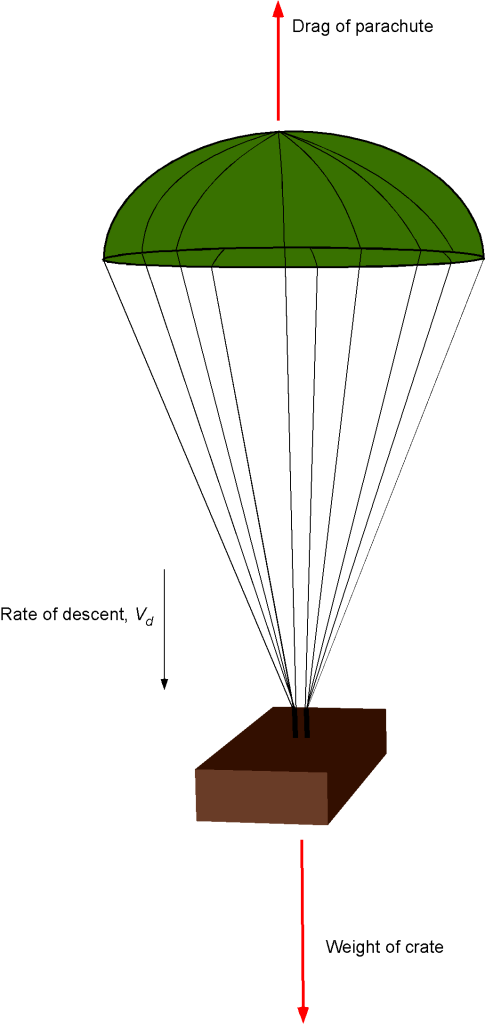
(a) In a steady descent, the net drag will be the sum of the drag produced by the parachute plus the drag of the crate, and this net drag must equal the weight of the crate, i.e.,
where is the drag coefficient of crate and
is the drag coefficient of the parachute. We are asked to solve for the vertical airspeed so
Rearranging and solving for the airspeed gives
Inserting the known values gives
(b) The time for the decent is found using
Worked Example #3
The wings of older airplanes were often stiffened by wires that provided cross-bracing, as shown in the figure below. Suppose the drag coefficient for the wing is based on the planform wing area (
ft
), determine the ratio of the drag from the wire bracing relative to the drag of the wing when the airplane is flying at 90 mph. Comment on your results. Assume MSL ISA conditions.

Hint: Obtain the drag coefficient of the wire by using the Reynolds number plot related to a smooth circular cylinder.
The drag of the wing is given by
where = 180.0 ft
and
= 0.034. The drag of the bracing wires is given by
The reference area of the wires is their total projected frontal area, so
where is the total length of the bracing wires, and
is the wire diameter. The determination of the drag of the wires requires the calculation of the Reynolds number of the wire, which is
noting that 1.467 is the conversion factor from miles per hour (mph) to feet per second (ft/s). From the drag coefficient versus Reynolds number for a circular cylinder, at = 16,100, the drag coefficient is about 1.4. Therefore, the total drag of the bracing wires relative to the drag of the wing is
Inserting the numerical values gives
Notice that the drag of the bracing wire is about the same as that of the unbraced wing. This was a big issue on early monoplanes, significantly limiting their speed capability. Later, improvements in structural design and stiffer wings led to significant increases in monoplane flight performance.
Notice also that the ratio of the drag values is NOT the ratio of the drag coefficients. This is because the definition of the drag coefficient depends on the reference area. In the case of a wing, the reference area is the planform area, but in the case of a wire, the drag coefficient is based on the projected frontal area. Therefore,
The ratio of the products of the drag coefficients and the reference areas is
where the “” values are known as the equivalent drag areas.
Worked Example #4
A general aviation airplane is equipped with a ballistic parachute recovery system for enhanced safety in the event of a severe emergency. Consider a scenario where the airplane’s pilot must deploy this parachute system from an altitude of 3,000 meters. Assume the airplane has a net mass of 1,200 kg, a projected cross-sectional area of 25 m, and a corresponding drag coefficient of 1.8 based on this area. The parachute has an area of 150 m
and a drag coefficient of 1.5 based on this area. During the descent, assume an average air density of 1.01 kg m
. Disregard the weight of the parachute. Determine the vertical airspeed at which the airplane will parachute to a landing. Approximately how long will the descent take?
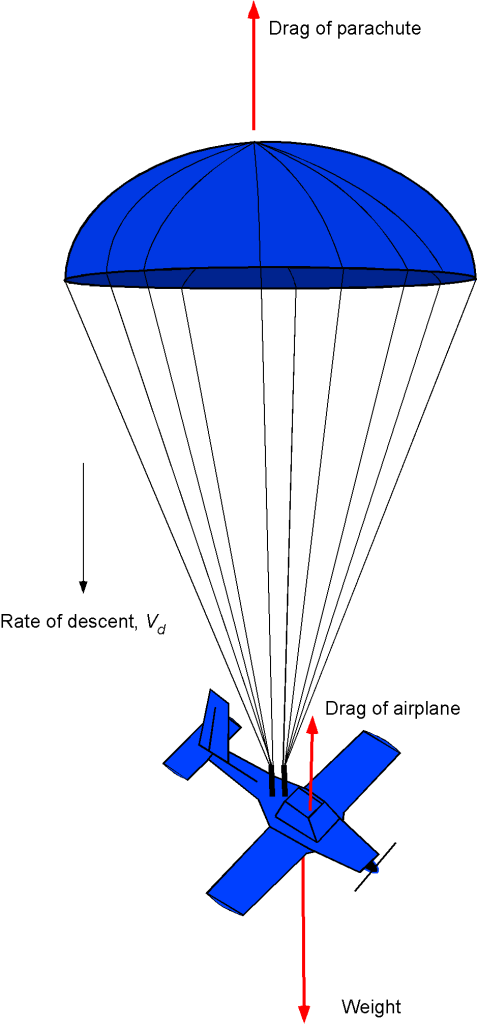
The airplane’s given drag coefficient is two orders of magnitude greater than expected during normal flight. The airplane is streamlined in normal flight, with minimal pressure drag and boundary layer separation. However, during descent with a parachute, the airplane behaves as a bluff body with large amounts of flow separation and corresponding pressure drag. During a steady descent, the net vertical drag on the airplane will equal its weight. The net drag will be the sum of the drag produced by the parachute and the drag of the airplane.
The net drag on the airplane and parachute will be equal to the weight, so
where is the rate of descent,
is the projected cross-sectional area of the airplane,
is the drag coefficient of the airplane based on this reference,
is the projected cross-sectional area of the parachute,
is the drag coefficient of the parachute based in this reference area. Simplifying gives
and rearranging to solve for gives
Substituting in the known numerical values gives
To compute the descent time , we can assume that the aircraft travels at this vertical speed for the entire change in altitude, so that
Worked Example #5
A re-entry spacecraft weighs 7,000 lb. At an altitude of 2,000 ft, a certain number of parachutes (to be determined) must open, each with a diameter
of 115 ft as the vehicle descends into the ocean. Based on their projected area, these parachutes have a drag coefficient
of 1.6. Assume that after the parachutes are deployed, the spacecraft quickly reaches a descent equilibrium velocity of
. During this time, the average air density is
0.0023 slug ft
. Ignore drag forces on the spacecraft itself.
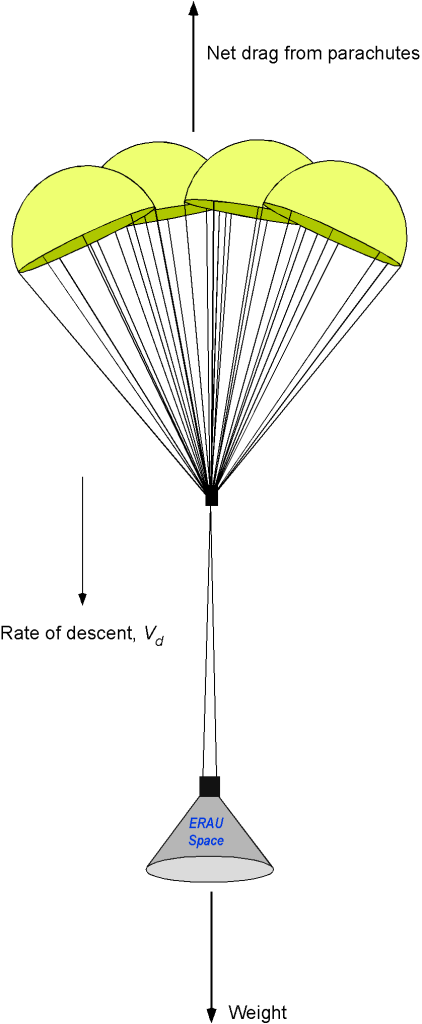
Determine an equation for the spacecraft’s rate of descent with the parachutes open. For example, if the maximum allowable impact speed of the spacecraft with the ocean is 10 ft/s, how many parachutes are required?
During a steady descent, the net vertical drag on the re-entry vehicle from the parachutes must equal the vehicle’s weight, i.e.,
, where
is the drag of any one parachute. The aerodynamic drag on any one parachute (a bluff body) will be
where is the rate of descent,
is the projected cross-sectional area of any parachute, and
is the drag coefficient of the parachute based on this reference area. The net drag on the
parachutes will be equal to the weight of the vehicle, so the force equilibrium equation is
Rearranging to solve for gives
which will determine the rate of descent for a given number of parachutes.
We are given the maximum allowable rate of descent, so further rearranging the force equilibrium equation to solve for gives
Substituting in the known numerical values gives
So, we will need four (4) parachutes to reduce the rate of descent to 10 ft/s.
Worked Example #6
As part of the design of a utility plant in Florida, a solid hemisphere must be tested in a wind tunnel to measure its drag at hurricane speeds. The hemisphere is 19 inches in diameter. It is to be tested in two conditions, the first with the rounded side into the wind and the second with the flat side into the wind. As part of the test plan, the drag force on the hemisphere must be estimated before it is mounted on the wind tunnel balance. Make a plot of the estimated drag force on this hemisphere, in both conditions, as a function of wind speed up to 145 mph. You may assume MSL ISA conditions.

The drag on the hemisphere will be given by the usual formula, i.e.,
where the reference area is
The drag is to be measured in two orientations, the first with the rounded side to the wind, i.e.,
where according to information given = 0.42. In the second case, with the flat side into the wind, then
where .
We are told the airspeed range is up to 145 mph, which is equivalent to 212.67 ft/s. Therefore, we must plot two curves for and
as a function of airspeed. Substituting the numbers and using MSL ISA conditions that
= 0.002378 slugs/ft
gives
and
where would be in units of ft/s. The plot below shows that drag will vary from approximately 45 lb with the rounded side facing the wind to approximately 115 lb with the flat side into the wind. Notice that the wind speed has been converted back to mph for plotting purposes.
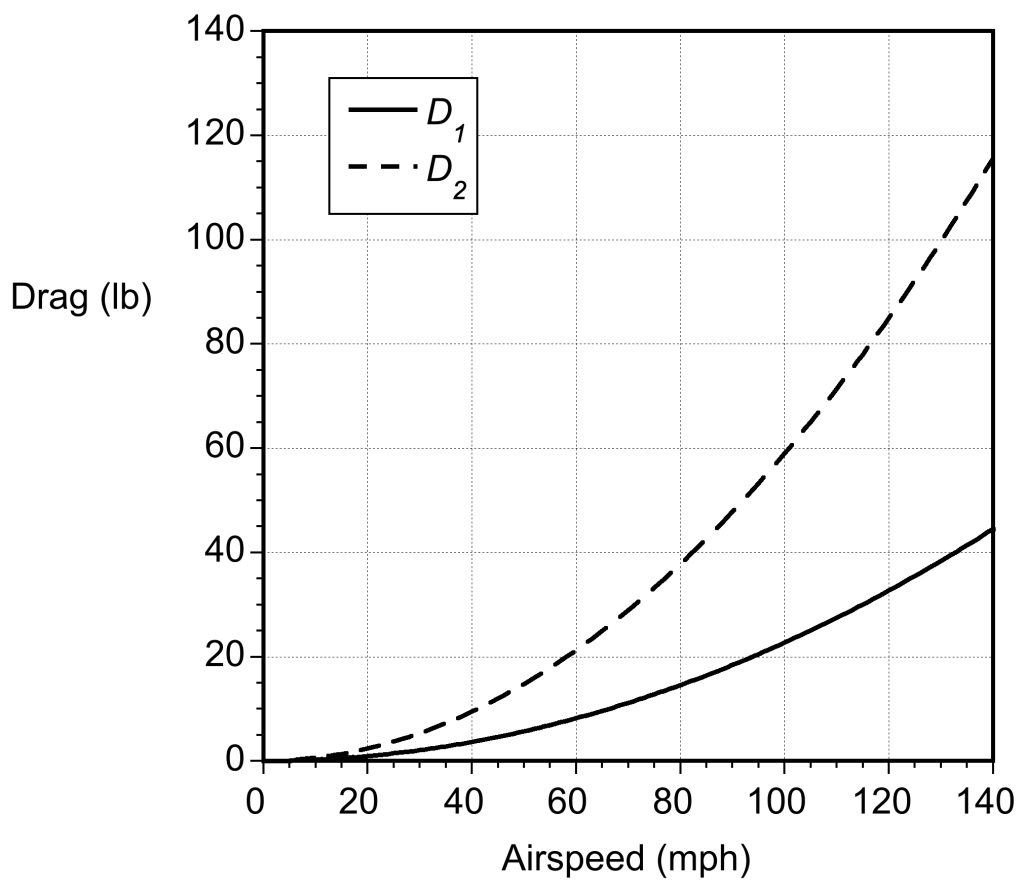
Worked Example #7
A helium-filled, spherical-shaped balloon with a smooth surface is tethered in a horizontal wind flow of 10.3 mph, as shown in the figure below. The diameter of the balloon is 55 cm, and the mass of the balloon material (not including the gas inside) is 20 grams. The pressure inside the balloon is 120 kPa. Assume MSL ISA atmospheric ambient conditions and for helium
= 2,077.0 J Kg
K
.
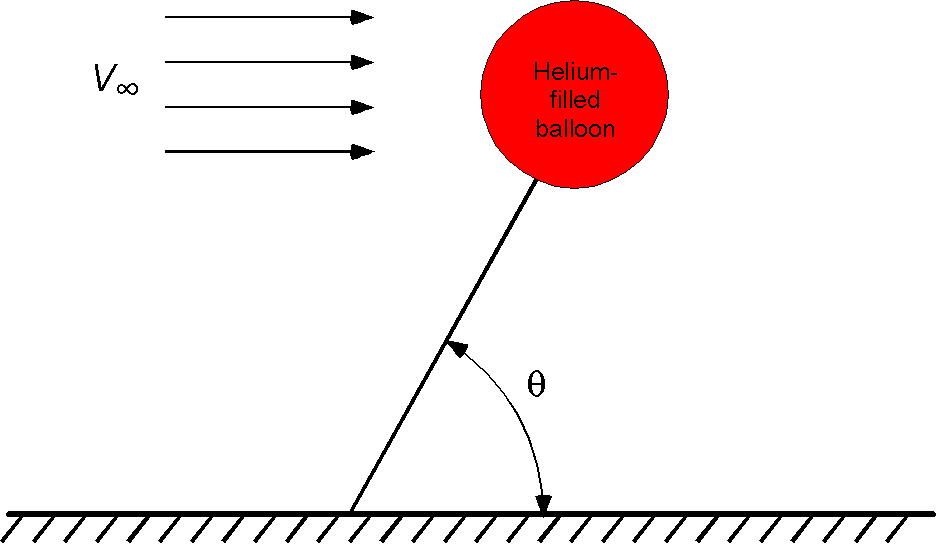
- Draw a free-body diagram to show the forces acting on the balloon at its equilibrium condition.
- Determine the density of the helium contained inside the balloon at its equilibrium condition.
- What is the Reynolds number
for the flow around the balloon?
- Determine the balloon’s drag coefficient,
. Hint: Use the chart for
for a sphere.
- Calculate the value of the equilibrium angle
.
- The buoyancy force, weight, aerodynamic drag, and tension from the string can be explained on a free-body diagram, as shown below.
2. Using the equation of state, the density of the helium gas in the balloon at 15C or 288.15 K is
3. The wind speed in base units of m/s is
Therefore, the Reynolds number based on the diameter of the balloon and the wind speed is
4. At , the value of
is approximately 0.39, per the standard drag chart for a sphere.
5. The projected frontal cross-sectional area of the balloon is
This means that the drag force on the balloon is
The volume of the spherical balloon is
In the vertical direction, the upward buoyancy force and weight
must be considered. The buoyancy force is
The weight of the balloon, , including the helium gas inside, is
Inserting the known numerical values gives
Finally, the equilibrium angle is determined from
Therefore, .


